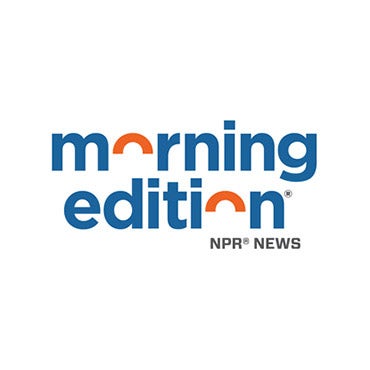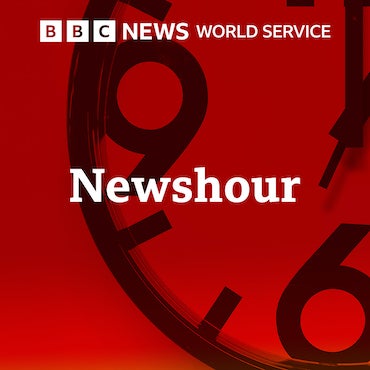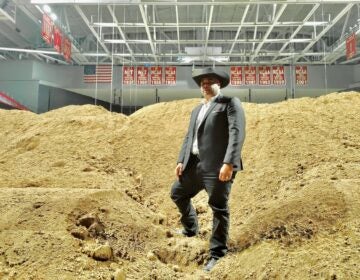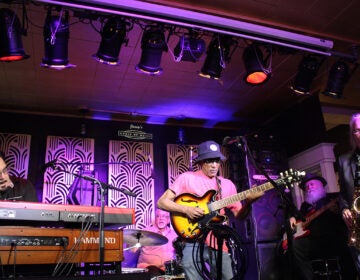‘The arts of everyday life’: Philadelphia Folklore Project archives now housed at Temple University Library
The archive will begin to be available to the public and scholars in 2026.
Listen 1:06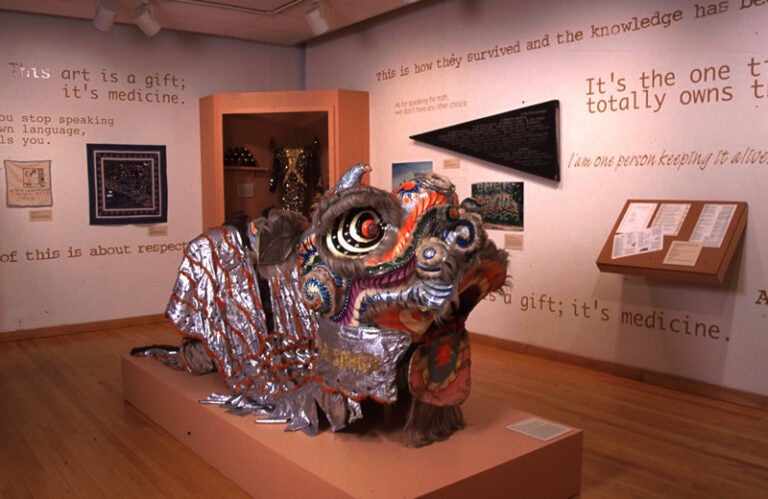
Artwork from Folk Arts of Social Change, installation view, 1999. Many of the objects and artworks featured in Philadelphia Folklore Project's exhibitions over the years are part of its archives, which now have a new permanent home at Temple University Library's Special Collections Research Center. (Courtesy of Philadelphia Folklore Project)
From Philly and the Pa. suburbs to South Jersey and Delaware, what would you like WHYY News to cover? Let us know!
The more than 75,000 folklore objects, artifacts, artwork and materials that make up Philadelphia Folklore Project’s archive now have a new home at the Special Collections Research Center at Temple University’s Urban Archives.
Founded in 1987, the Philadelphia Folklore Project has promoted, documented and supported Philadelphia area folk arts, traditions and culture for more than three decades. Part of that work has been collecting and preserving tens of thousands of folklore objects, documents and artworks from the city’s myriad of cultures.
“We’ve created a tremendous archive of ethnographic fieldwork and documentation of different kinds of cultural practices, as well as materials that were either used or part of the research for the development of exhibitions, films, podcasts, performance series,” said Mia Kang, executive director of PFP. “So it’s all kinds of different materials, but mainly relating to the practices of folk and traditional artists in Philadelphia, as well as a lot of material that documents the connection between folk arts and grassroots movements for social change.”
Those materials include documents and objects related to Philadelphia’s Odunde Festival, texts in a range of different languages, and one of Kang’s personal favorites, traditional embroidered textiles by Hmong-Philadelphian artist Pang Xiong, who passed away in 2020.
“It’s materials like that that are made by people who are everyday artists, right?” Kang said. “Folk arts, we think of as the arts of everyday life, so things that are part of people’s day-to-day existence, part of the sort of social fabric of their communities and how they think of themselves and their cultural heritage.”
Kang said PFP, as a small organization, was faced with challenges in caring for and storing such an extensive archive, as well as making it easily accessible to the public.
“Because we’re not a library, it’s been, I think, tough to maybe have these materials see as wide an impact as they might if we were a more traditional research institution,” she said. “Temple is a great home for the archive, because people are already used to going there to find stuff that they might be using in their research, or to inspire their artwork or to learn about the history of Philadelphia.”
Although the agreement between PFP and Temple was established before the pandemic, the archive was moved to its new home in February.
Melissa Minds VandeBurgt, director of Temple Library’s Special Collections Research Center, said the center has hired a full-time archivist to prepare the archive. The collection will begin to be available to scholars and visitors in 2026, with a plan to digitize materials and make them globally accessible online in the future.
Minds VandeBurgt said the partnership is a “perfect pairing.”
“Temple’s Urban Archives has been a model for developing archival collections that represent communities that have historically been omitted from the archival record,” she said.
Minds VandeBurgt said the goal is to make the materials available to anyone who wants to study and review them.
“Everything that we have at the [center] is available for the public,” she said. “You don’t need to have a reason to want to see it other than the fact that you want to. We are the city’s public institution. Everything we have here is for the city and for people to come to you. You do not need to be a scholar. You just have to be curious.”
Centering folklore traditions and history in an academic institution is vital work, Minds VandeBurgt said.
“I think what is important about this collection, and what we do here at Temple in the Urban archive, is that we’re acknowledging that our institutions are rooted in systems of marginalization,” she said. “And we’re combating that in a city like Philadelphia that is so rich and diverse, and has celebrated that, and celebrated social justice, celebrated activism.”
Kang said PFP is in the midst of a strategic planning process and is looking to continue to “meet people where they’re at” through a pilot partnership offering free arts workshops with The Free Library of Philadelphia. PFP is also planning to establish a permanent community advisory board to inform their exhibitions.
Philadelphia, she said, has a special folklore tradition that the organization works to preserve and celebrate.
“When you think about folklore, right, the sort of like stories or shared cultural experiences that make up the fabric of a community, we have so much folklore in Philadelphia, right?” Kang said. “Like greasing the poles, for example, I would consider a kind of folklore … I’ve just never experienced a place that was so kind of serious and yet playful with its kind of cultural identity, and that was so richly diverse in terms of the different immigrant communities that we have here.”
The city’s diverse immigrant communities contribute to its rich folklore traditions, Kang added.
“We’ve always as an organization focused particularly on low income immigrant and refugee groups, and I think this is just a really welcoming city, and what that means is that people come here and they’re able to kind of find a way to make a home,” she said. “And that means a lot of really interesting cross cultural exchanges among different communities, as well as, just like, I think, a lot of coalitional solidarity across different groups.”

Get daily updates from WHYY News!
WHYY is your source for fact-based, in-depth journalism and information. As a nonprofit organization, we rely on financial support from readers like you. Please give today.
